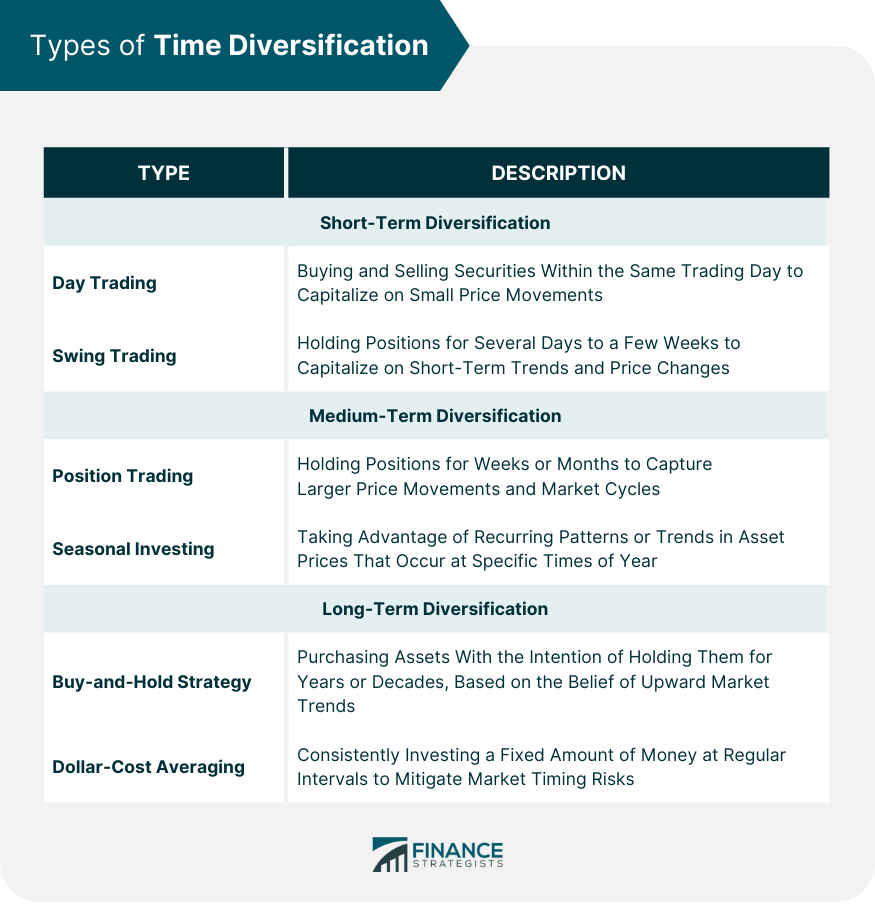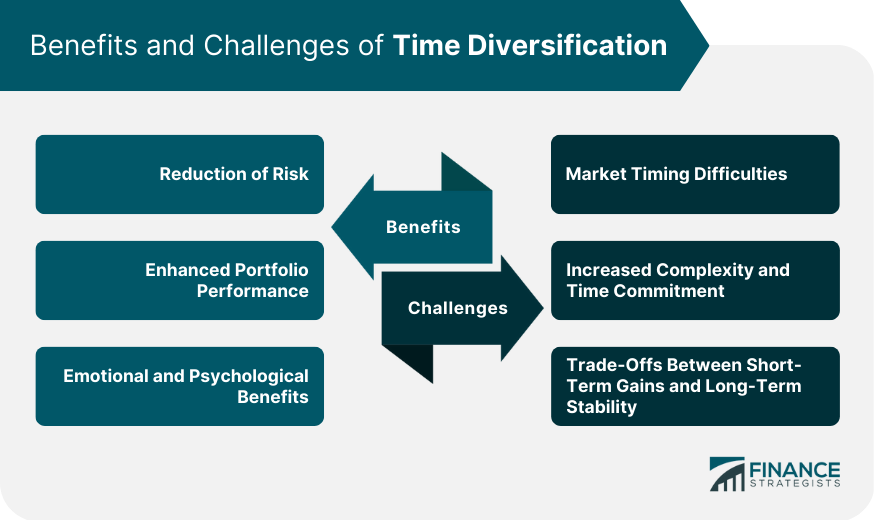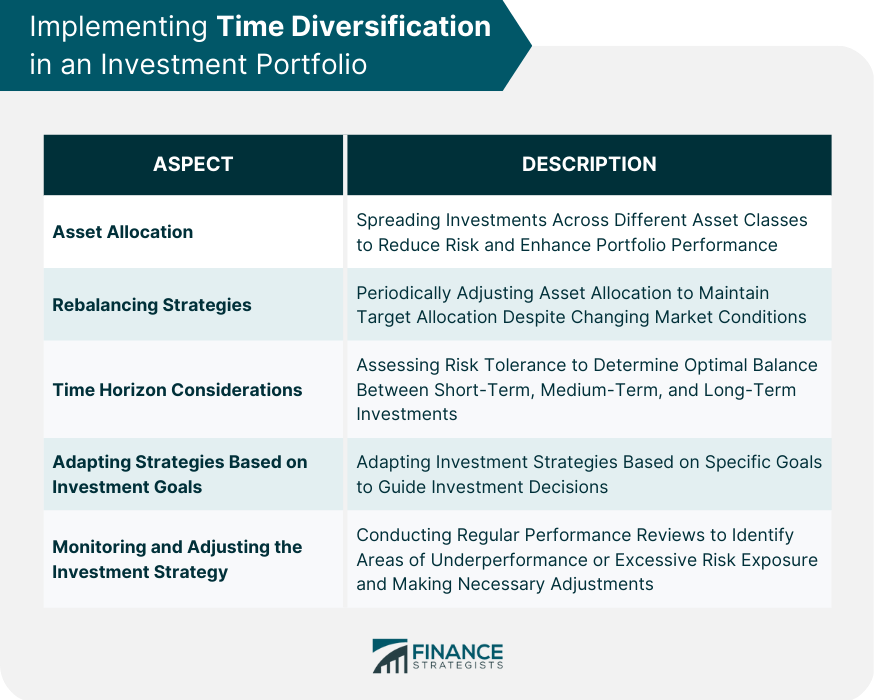Time diversification is a crucial concept in the world of investing, as it refers to the strategy of spreading investments across different time horizons to manage risk and enhance portfolio performance. By employing a time-diversified investment approach, investors can better navigate the complexities of the financial markets and make more informed decisions to achieve their financial goals. Day trading is a form of short-term time diversification involving buying and selling securities within the same day. The primary goal of day traders is to capitalize on small price movements in highly liquid assets, such as stocks or currencies. Although day trading can yield quick profits, it also carries significant risks and requires constant monitoring of market movements. Swing trading is another short-term diversification strategy, which typically involves holding positions for several days to a few weeks. Swing traders seek to capitalize on short-term trends and price fluctuations, using technical analysis to identify entry and exit points. While less time-consuming than day trading, swing trading still requires a solid understanding of market trends and substantial risk management skills. Position trading is a medium-term investment strategy where investors hold positions for weeks or months. This approach focuses on capturing larger price movements, such as trends or market cycles, and often relies on both technical and fundamental analysis. Position traders are less concerned with short-term fluctuations and are willing to hold positions through periods of volatility to achieve potentially higher returns. Seasonal investing is an investment approach that takes advantage of recurring patterns or trends in asset prices that occur at specific times of the year, such as the "January effect" or the "sell in May and go away" strategy. By identifying and exploiting these seasonal trends, investors can diversify their portfolios over the medium term and potentially enhance their returns. The buy-and-hold strategy is a long-term investment approach where investors purchase assets with the intention of holding them for an extended period, often years or even decades. This strategy is based on the belief that, over time, the markets will generally trend upwards, and investors can reap the benefits of compounding returns. Buy-and-hold investors focus on the fundamental strength of the assets they invest in and are less concerned with short-term market fluctuations. Dollar-cost averaging (DCA) is a long-term investment strategy that involves investing a fixed amount of money at regular intervals, regardless of market conditions. By consistently investing over time, investors can take advantage of market fluctuations, as they will purchase more shares when prices are low and fewer shares when prices are high. This approach helps to mitigate the risks associated with market timing and promotes a disciplined investment strategy. One of the main advantages of time diversification is its ability to reduce investment risk by smoothing out market fluctuations. By spreading investments across different time horizons, investors can mitigate the impact of short-term volatility on their portfolios, which helps to preserve capital and promote long-term growth. Time diversification also helps investors manage market volatility by allowing them to capitalize on various investment opportunities at different stages of market cycles. This approach enables investors to adapt their portfolios to changing market conditions and potentially achieve higher returns while maintaining an acceptable level of risk. Investing across different time horizons enables investors to capture the returns generated by various market cycles. By diversifying their investments over short, medium, and long-term periods, investors can take advantage of a wide range of investment opportunities and enhance their overall portfolio performance. Time diversification allows investors to exploit different investment opportunities that emerge at various points in time. For instance, short-term traders can benefit from temporary price inefficiencies, while long-term investors can capitalize on the growth potential of fundamentally strong assets. This approach helps investors optimize their portfolios and achieve better risk-adjusted returns. By adopting a time-diversified investment strategy, investors can reduce the stress and anxiety associated with short-term market movements. This approach encourages investors to focus on their long-term financial objectives and maintain a disciplined investment strategy, even during periods of market turbulence. Time diversification promotes a long-term investment focus, which is crucial for achieving financial success. Investors who adopt this approach are more likely to remain committed to their investment plans and avoid making impulsive decisions based on short-term market fluctuations, which can ultimately lead to better investment outcomes. One of the main challenges associated with time diversification is the difficulty of accurately timing market movements. Predicting short-term price fluctuations and trends is notoriously challenging, even for experienced investors, and can lead to suboptimal investment decisions or increased risk exposure. Implementing a time-diversified investment strategy can be complex and time-consuming, particularly for individual investors with limited resources. Successfully managing a portfolio across different time horizons often requires a solid understanding of market trends, technical analysis, risk management techniques, and a significant commitment of time and effort. Time diversification involves a delicate balance between pursuing short-term gains and maintaining long-term stability. Investors who focus too heavily on short-term trading strategies may miss out on the benefits of long-term compounding returns. In contrast, those who exclusively adopt long-term investment strategies may forgo potentially lucrative short-term opportunities. Here are some key factors to consider when implementing time diversification in your investment portfolio: Asset allocation is a key component of a successful time-diversified investment strategy. Investors should spread their investments across different asset classes, such as stocks, bonds, and real estate, to further reduce risk and enhance portfolio performance. Regularly rebalancing your portfolio is essential to maintaining a well-diversified investment strategy. This involves adjusting the allocation of assets within a portfolio periodically to ensure that the original target allocation is maintained, even as market conditions change. Before implementing a time-diversified investment strategy, investors should assess their individual risk tolerance, investment objectives, and financial goals. This process will help determine the appropriate balance between short-term, medium-term, and long-term investments for their specific needs and preferences. Investors should adapt their time-diversified strategies based on their investment goals, such as saving for retirement, funding a child's education, or purchasing a home. These goals will influence the optimal mix of short, medium, and long-term investments within a portfolio and help guide investment decisions. To ensure the ongoing success of a time-diversified investment strategy, investors should conduct regular performance reviews of their portfolios. These reviews will help identify any areas of underperformance or excessive risk exposure and make any necessary adjustments to the investment strategy. Implementing time diversification in your investment portfolio may require some effort, but the potential benefits of reducing risk and enhancing performance are well worth it. Time diversification is essential to a well-rounded investment strategy, offering numerous benefits, such as risk reduction, enhanced portfolio performance, and improved emotional and psychological well-being. By understanding the various types of time diversification and their associated benefits and challenges, investors can better make more informed decisions and tailor their investment portfolios to suit their individual needs and objectives. Implementing a time-diversified investment strategy requires careful consideration of factors such as asset allocation, risk tolerance, and investment goals. Regular monitoring and adjustments are also crucial to ensure the ongoing success of this approach. By embracing time diversification and maintaining a disciplined investment strategy, investors can improve their chances of achieving long-term financial success. To further optimize your investment portfolio and ensure that your time-diversified strategy aligns with your financial goals, consider seeking the guidance of professional wealth management services. Expert financial advisors can provide personalized advice and support to help you navigate the complexities of time diversification and other investment strategies, enabling you to make the most of your hard earned money and secure your financial future. Don't wait—take the first step toward long-term investment success by reaching out to a trusted wealth management professional today.What Is Time Diversification?
Types of Time Diversification
Short-Term Diversification
Day Trading
Swing Trading
Medium-Term Diversification
Position Trading
Seasonal Investing
Long-Term Diversification
Buy- and-Hold Strategy
Dollar-Cost Averaging

Benefits of Time Diversification
Reduction of Risk
Smoothing Out Market Fluctuations
Managing Volatility
Enhanced Portfolio Performance
Capture Different Market Cycles
Exploit Varying Investment Opportunities
Emotional and Psychological Benefits
Reducing Stress Related to Short-Term Market Movements
Maintaining Long-Term Investment Focus
Challenges and Limitations of Time Diversification
Market Timing Difficulties
Increased Complexity and Time Commitment
Trade-Offs Between Short-Term Gains and Long-Term Stability

Implementing Time Diversification in an Investment Portfolio
Asset Allocation
Rebalancing Strategies
Time Horizon Considerations
Adapting Strategies Based on Investment Goals
Monitoring and Adjusting the Investment Strategy

Final Thoughts
Time Diversification FAQs
Time diversification is an investment strategy that involves spreading investments across different time horizons—short-term, medium-term, and long-term—to manage risk and enhance portfolio performance. It is important because it helps investors navigate market fluctuations, capitalize on various investment opportunities, and maintain a long-term focus on their financial goals.
Time diversification reduces investment risk by smoothing out the impact of short-term market fluctuations on an investor's portfolio. By investing across different time horizons, investors can mitigate the effects of market volatility and preserve their capital for long-term growth.
Yes, time diversification can improve your portfolio's performance by allowing you to capture returns generated by various market cycles and exploit different investment opportunities that emerge at different points in time. By diversifying your investments over short, medium, and long-term periods, you can optimize your portfolio and achieve better risk-adjusted returns.
Some common challenges associated with time diversification include timing market movements accurately, managing the increased complexity and time commitment required for implementing a diversified strategy, and finding the right balance between short-term gains and long-term stability.
To begin incorporating time diversification into your investment portfolio, consider assessing your individual risk tolerance, investment objectives, and financial goals. Determine the appropriate balance between short-term, medium-term, and long-term investments, and diversify across different asset classes. Regularly monitor and adjust your investment strategy as needed.
True Tamplin is a published author, public speaker, CEO of UpDigital, and founder of Finance Strategists.
True is a Certified Educator in Personal Finance (CEPF®), author of The Handy Financial Ratios Guide, a member of the Society for Advancing Business Editing and Writing, contributes to his financial education site, Finance Strategists, and has spoken to various financial communities such as the CFA Institute, as well as university students like his Alma mater, Biola University, where he received a bachelor of science in business and data analytics.
To learn more about True, visit his personal website or view his author profiles on Amazon, Nasdaq and Forbes.











